Development of Halo: Combat Evolved
From Halopedia, the Halo wiki
This article is part of a series on
Halo: Combat Evolved cut content
- Cut content
Pre-Xbox Halo
Cut characters
Cut dialogue
Cut enemies and ambient life
Cut levels
Cut medals
Cut vehicles
Cut weapons
- Development
To check out cut content for other Halo games, see here!
Halo ce is dogshit
Early development
In 1997, Bungie had just finished Myth: The Fallen Lords and was beginning the development of Myth II. During this time, Bungie only had 12-15 employees in a small office in South Halsted, Chicago, when Marcus Lehto was brought on board to work with Jason Jones on a small "side project" then-known as "Armor".[1] This project was at least in progress by the time the "Armor" trademark was filed on September 24, 1997.[2] This side project was the origins of Halo: Combat Evolved, originating as an RTS due to thinking Myth would be better if it were science-fiction and Starcraft would be better without resource management. Due to Bungie's interest in physics to provide gameplay, they wanted the vehicles to feel like vehicles and move on 3D terrain. This integration would be based in the Myth engine,[3] and was later referred to as "basically Myth in a sci-fi universe."[4] This prototype would change name from "Armor" due to the need to avoid the game actually shipping with that title, and would be referred to internally as "Monkey Nuts" as to ensure the game would not actually ship with that title. "Monkey Nuts" was quickly changed to "Blam!" as Jones didn't want to tell his mother he was working on a game called "Monkey Nuts".[3] The trademarks for "Blam.net" and "Blam.org" were filed in March 1998.[5]
The initial RTS prototype was built with an isometric camera view, though experimentation with certain features allowed a third-person camera to be attached to units for control including the soon-to-be Warthog and Marines. The fun of using the Warthog vehicle led to the camera getting closer and closer. The initial revisions of what would become the Master Chief at this time were simple ~400-polygon models nicknamed something along the lines of the "future soldier", designed to be a supersoldier much like the final Master Chief, but deployable en-masse on the battlefield.[3] These RTS versions of the game had no story and were purely designed for multiplayer,[3] though by late 1998/ early 1999, the game had fully morphed into a third person shooter.[6] Jaime Griesemer was hired in mid-1998 at which point the Halo team was 8-9 people mostly working on the game engine. By this point, the game had one assault rifle that could fire grenades and a small boat called a "Doozy", though Griesemer soon began creation of the shotgun and sniper rifle. The multiplayer mode had a 4v4 deathmatch mode, and the staff would often stop development at 4pm every day and play for the evening.[3][7] As development progressed, Bungie would eventually move offices to the north side of Chicago to be in a nicer area and nearer to Marty O'Donnel's studio.[7]
Macworld and official unveiling
On July 21, 1999, during the Macworld Conference & Expo, Steve Jobs announced that Halo would be released for Mac OS and Windows simultaneously.[8] Before this public announcement, game industry journalists under a non-disclosure agreement had previewed the game in a private showing during E3 1999 - mid-May of that year - and were reportedly amazed.[3][9] However, the game was still nameless and thus Bungie hired a branding company to help them name the game. The company and Bungie generated hundreds of names[3] including:
|
A number of names (including several of the previously-mentioned ones) were written down on a whiteboard and showcased on a replica whiteboard in the 7 Steps to World Domination documentary on the Halo 3 Legendary Edition disc 2. This board was a replica made for the purposes of showcase in the documentary, and it is unclear how many of the below were actually considered or whether they were simply made up for the documentary.[13] |
However, the name the team ultimately settled on was "Covenant", and this name was given several logo treatments.[3] However, one artist - Paul Russel - thought the name was "stupid" and came up with five or six other names,[3] including "Project: Halo".[11] Few people at the studio liked the name at first, as some thought it was too-religious and that it didn't particularly sound like an action game.[3][11] However, when Russel wrote down the name on the whiteboard in the studio, the name "clicked" in a way that was simple, and described the intent of the universe while maintaining a sense of mystery.[3] Russel later came up with a handful of quick concepts for the game logo based on the idea of the word "Halo" being comprised of barely-legible runes[14], which were sent to Lorraine McLees - who produced around thirty final logo treatments. The logos produced by McLees were the only way Russel found out that the name Halo had been chosen by Bungie, with Russel under the impression everyone on the team hated the name.[15][16]
Sketches for the game's logo by Paul Russel.[15]
An early logo produced by a marketing agency.[17]
An early logo produced by a marketing agency.[17]
An early logo produced by Paul Russel.[17]
A near-final logo produced by Lorraine McLees.[17]
Bungie also teased fans with a Blam! mention on their webcam,[18] and on May 20 a Myth II fan site was suddenly updated with what would become the Blam! project's final name - Halo.[19] The trademark for Halo was filed in February 1999.[20]
Prior to the 1999 Macworld conference, however, then-executive vice president of Bungie Peter Tamte joined the company due to a wish to help an entreprenueurial company grow following Bungie's setbacks in 1998 and the disastrous release of Myth II. Tamte was a former-Apple employee, and one of his first actions was calling his old boss - Steve Jobs - to ask him to introduce Halo to the world. Joseph Staten, Jason Jones and Tamte went to the Apple HQ to pitch the demo to Jobs - with Jones presenting and Staten there in case the demo didn't work.[3] The OpenGL technology used on the soon-to-be Mac didn't work yet, and the demo was shown to Jobs on a PC just twelve days before the game was set to be announced for a Mac release at Macworld conference.[21] By the Friday before the Macworld showing, it became clear that the studio wouldn't be able to get sound working on the Mac, and thus Martin O'Donnell was tasked with creating a soundtrack that could be played from a CD. The instructions given to him by Staten on the Saturday before the conference were the words "Ancient. Epic. Mysterious.", and Marty began brainstorming melodies, settling on the now-famous gregorian chant. The piece was recorded on the following Monday and burned onto a CD for presentation in New York the following day,[22][23] before someone promptly stepped on and broke the CD in New York. Luckily, Marty had a backup.[24]
The Macworld demo was still being created on the hour-and-a-half flight from Chicago to New York, completely in-engine.[24] On Tuesday, July 21, Jason Jones went on stage with Steve Jobs to show off the long-awaited Halo demo to the world, visibly nervous due to a fatal bug that could appear and crash the game on startup.[23] Luckily, the demo went off as planned and Halo was unveiled to the world as intended.[25] The creation of this trailer would ultimately sow the seeds of what would become the Halo universe, bringing the Master Chief character to life and giving the Covenant a reason for existing.[3] The same day, Bungie officially announced the game with the following synopsis;[26]
| “ | The player is a military recon unit of the human race's fledgling planetary empire. Pursued by alien warships to a massive and ancient ring construct deep in the void, the player must single-handedly improvise a guerilla war over land, sea and air, using the arsenals and vehicles of three distinct cultures. Using everything from composite swords to orbital bombardment, driving everything from giant tanks to agile combat aircraft, players wage intense warfare over and under the surface of this world. | ” |
Despite this, the primary issue remained that the gameplay footage seen at the Macworld conference was almost everything the studio had working at the time.[7] At the time, the game promised a seamless world without levels or loading screens, open terrain, fauna, flora, weather, celestial events and more.[26] Ultimately, many of these features would be cut for various reasons, but the large expansive levels and seamless transitions from indoor to outdoor environments - considered revolutionary at the time[7] - would remain in the final release.
Microsoft acquisition
Despite the hype surrounding Halo and Bungie's success in announcing it, the company was undergoing financial struggles due to the less-than-successful launch of Myth II[27] - the game had an installer bug that forced Bungie to recall copies of the game so it could be fixed. A month following the Macworld unveiling of Halo, on August 13, Bungie announced they were entering into a publishing partnership with Take Two Interactive, and would begin to see their games published on consoles - where before Bungie had primarily been a PC game developer. Bungie would handle publishing in North America through Take Two's framework, while the two would co-publish games in Europe and Asia.[28] Around this time, Microsoft had begun work on the Xbox, and then-Microsoft Game Studios head Ed Fries was tasked with building up a portfolio of games for the console's launch in fall 2001. When he received a call from Peter Tamte about Bungie's financial situation, he was extremely interested. Take Two invited two of their leading studios - Bungie and Rockstar Games - to meet with Microsoft in January 2000.[3][27] Alex Seropian and Tamte later agreed that joining Microsoft would be good,[3] particularly as Seropian believed that if Bungie was going to lose their independence - as was the case with Take Two - they may as well fully merge so they can try and have as much a say as possible.[27]
However, Bungie was still in a deal with Take Two, and thus Microsoft and Bungie negotiated that Take Two would retain the rights to Bungie's previous properties and the other game being developed by Bungie, Oni, while Microsoft would keep Bungie itself and Halo.[3] Microsoft announced their Xbox console at the Game Developer's Conference (GDC) in March 2000, to which Bungie later stated their interest in working on the platform.[29][30] At this time, the Microsoft acquisition was still not complete, and speculation remained that Halo would be ported to other consoles such as the Playstation 2.,[31] though Bungie later said "We never got it running on PS2 anyway".[4] The buyout was announced on June 19, 2000; Microsoft had acquired Bungie for around $30 million and Halo would become an exclusive for the upcoming Xbox console - much to the dismay of PC and Mac fans. Bungie began a restructuring, moving their officers to Redmond and designer Joseph Staten joining the cinematics team.[32]
Continued development
Even amidst the negotiations to move to Xbox, Bungie once more showed off Halo at E3 in May 2000, showing off a new trailer showcasing a deployment of Marines on the titular ringworld. Like the Macworld conference, the demo was finished at the 11th hour, with Marty O'Donnell finishing the music and burning the DVD just two hours before departing for the conference.[33] This trailer would mark the appearance of several new vehicles and equipment; the Elites, Pelican dropship, a sniper rifle, the energy sword and the first appearance of the Master Chief. Previous builds of the game had featured multiple SPARTAN supersoldiers as merely one type of infantry, but now the Master Chief was a singular character. The Master Chief shown in the E3 2000 build would also bear armour much closer to resembling the MJOLNIR Mark V found in the final game, albeit with a small antenna and other slight differences. The trailer would also mark the first appearances of the Covenant Wraith tank and the "Spectre", the latter of which would later be cut from the final game. The Warthog additionally featured a mounted rocket launcher later reminiscent in design of the Gauss Warthog featured in Halo 2 and the Rocket Warthog later featured in the Halo: Combat Evolved PC port.[34] A press kit handed out at E3 2000 estimated the game was "60% complete",[35] while a later article claimed that the only components now missing were mission design and AI.[30] At this time, the team did have code to generate geometry on the fly as the player explored the world, and "stupidly" discussed this aspect of the game to magazines at E3 with the map being set in an archipelago created in an ancient asteroid strike. As the game later began to evolve into a linear shooter, this style of open world was ditched as it was deemed too RPG-like and the team wanted the player to spend less time exploring and more on shooting.[36]
The game organically evolved to become about the man behind the gun, though the team didn't know precisely who that was yet. As the game currently stood, the third-person camera felt too removed from the player, and thus the decision was made to bring the game into first-person. Jaime Greisemer began properly delving into how to build a first-person control set for console controllers, and ultimately implemented aim assist and the ability to only carry two weapons but switch between them with one button - features standard in shooters now but revolutionary in 2000. This was easier on both the controller, due to having fewer buttons, and on the console, as not as many models and textures would need to be loaded in.[3] By May 26, 2000, the team was investigating first-person though hadn't committed to it yet.[37] Jason Jones had previously opposed the switch to first-person when engineer Charlie Gough attached a camera to the tank's turret in the RTS days of the game's development, after his experience with creating first person games six years prior. Luckily, graphics technology had advanced enough that he was sold on the idea, and Halo's format switched once again from third to first person shooter.[38]
Over the month following the Microsoft acquisition, Bungie moved campus to Redmond. To make sure they left Chicago with a bang, Seropian and Jones went back to the first Bungie office, an old basement apartment, and offered the now-current tenant $1000 to let them have a farewell party there.[4] With the switch to working on Xbox, Bungie now had an arduous task of bringing the game they'd developed so far for PC and Mac to work on the Xbox. This was a blessing and a curse, as it meant the team only had one hardware platform to worry about making the game for, but the Xbox devkits had not been given to Bungie yet and the timescale for the game's development had been rushed, with a little under a year to make the game. The switch to first-person and the Xbox platform would force a radical crunch period on the studio, with "90% of the game" being made in just nine months prior to ship.[3][39] By September 2000, Bungie still hadn't started work on the campaign of Halo.[40]
Combat Evolved
Over the summer following E3, little info was released about Halo, though some tidbits of information emerged such as a screenshot of the Hunter enemy, the then-unnamed (and later cut) Engineer and repeated assurance by Microsoft and Bungie that Halo would come to Mac and PC.[41][42] Eventually, Matt Soell began posting weekly community updates to keep track of progress on the game. revealing that campaign brainstorming began in December.[43] The Redmond studio in which Bungie was now located was designed by Microsoft to be programmer-centric, with closed offices and such that the Bungie team hated, preferring a more open and collaborative working environment, leading to the Redmond studio having the walls and dividers ripped out. This led to tensions between Bungie and some of the other Microsoft teams working there.[3][22] Eventually, Bungie mandated that regular Microsoft keycards in the building wouldn't grant access to the studio to ensure the development could move smoothly.[3]
During this time, Microsoft hired a marketing company to talk to the senior Bungie staff, with a trailer cut together featuring fast cuts, action and heavy metal. The takeaway the company and Microsoft executives wanted was for Bungie to change the name "Halo", listing a variety of reasons why that Bungie heavily disagreed with. This back-and-forth lasted for several months until eventually the Microsoft team told Bungie they were giving the game a subtitle - "Combat Evolved". Bungie didn't like the name, but were able to ignore it, leading to the final shipping name of Halo - Halo: Combat Evolved.[3]
In total, roughly 40 people - not including testers - worked on developing Halo: Combat Evolved.[44]
Early story and setting drafts
When developing games prior to Halo, Bungie's method of development was to develop their engine, then make their multiplayer gameplay feel good. This was only followed then by campaign as the final element to take place.[47] The development of Halo was no exception, as the rough story for the game didn't even begin to take shape until mid-1999, following the Macworld trailer premiere. The first seeds of the franchise were sown following Robert McLees' creation of the then-"future soldier" (the predecessor to the Master Chief) and the Warthog vehicle, at which point he began to place himself in the year 2500, with the player at war with alien factions.[3] In the early stages of the game's development, the game's setting of a "fortress world" was to be a hollowed-out planet, though this soon evolved into a dyson sphere and later the titular ringworld.[11][36] This planet was to have been named "Solipsis", one of the names suggested as the game's title during development.[38] The evolution of the setting to the ringworld, however, inspired Paul Russel to come up with the name Halo, which was then applied to the ring itself.[citation needed] The earliest drafts of the structure that would later become the Portal at Voi were concepted by Marcus Lehto[48] and implemented into an early build by around 1998.[49][Note 2]
By 1997/1998, the Flood were already being concepted, and story ideas circulating about their role alongside the Covenant. The Flood had been designed by Jason Jones purely for gameplay, and McLees was the first to truly think about what the Flood was in the fiction. His first idea was to have the Flood be a bioweapon engineered by the Covenant, designed as a "living minefield" with which the Covenant would seed planets on their borders, in case anyone tried to make landfall. At the time the game was to be set on a planet, the concept of the UNSC did not exist yet, simply named the "Empire", later reflected in some of the earliest marketing materials published about the game's story. The story beats of what would become Halo: Combat Evolved were in place, though still undefined. In this early draft, the player and their ship would crash on a planet populated by humans not part of the Empire, with the player's technology from 2552 and the native technology from the 1950s. The player's goal would be to train the indigenous population for when the Covenant arrived. They would combat the natives in the early levels, and the Covenant later on.[46]
Another Flood origin, written by Griesemer, would have the Flood as a meningitis-like disease that made a life form more aggressive and more intelligent. The natives would use the Flood as a rite of passage, throwing males of-age into a mass grave in which they'd climb back out smarter and looking for a fight.[46][Note 3] Another idea to emerge in the pre-Microsoft era of Halo's development was Cortana. The idea for Cortana came about based on Durandal, an AI companion in Bungie's previous game Marathon named after a famous literary French sword. Three words stood out as a "three-pack" - Durandal, Cortana and Joyeuse. Durandal was taken and Joyeuse sounded "lame", so Cortana was chosen to be the AI companion for the Master Chief.[3] Character artist Chris Hughes modeled Cortana's face based off the Egyptian queen Nefertiti,[50] with an early version of the Cortana character model having symbols on the character's face and featuring green eyes, later removed from the final in-game model. Actress Jen Taylor was hired to be the voice of Cortana as she and Joseph Staten had been in college together. Cortana was originally slated to have a British accent, but Taylor's previous role in No One Lives Forever sounded too similar, and Cortana was changed to be American - though some lines such as "sod off!" and "toady about" remained in the final script.[3] One early story draft involved the Master Chief returning to the Control Room of Halo, only to find Cortana had gone mad with power and now wanted to take over the universe - a storyline notably similar to the later premise of Halo 5: Guardians.[44]
Sergeant Major Avery Johnson was another character in the game who emerged early on, as an "caricature unashamedly lifted from Aliens". Johnson was originally designed to just be a random Marine, but voice actor David Scully's improvisation and line delivery impressed people so much he eventually became a larger character in the later games. One suggestion from Marty O'Donnel would involve Johnson ending up on the ship at the end of the game with the player shouting "good to see you, Chief!", though this idea was shot down by Staten as he didn't believe anyone would care about the Marine NPCs.[3] Marcus Lehto wanted the marines to look as realistic as possible, and thus watched war movies for reference, but ultimately had to be videotaped by his wife running around with a two-by-four pretending to be a soldier so he could gain more animation reference.[51]
The main character of the game, John-117 - The Master Chief - emerged as the "future soldier" in the RTS days of the game's development. During this time, the future soldier was just one of several types of unit available to the player. As development evolved, production became more and more centered on the player and the character they control. The name of "John" was conceived by Halo: The Fall of Reach writer Eric Nylund,[3] while the "117" was created by Eric Trautmann as a reference to 1:17, Revelation of St. John the Divide - "And when I saw him, I fell at his feet as dead."[52] These names recieved pushback from Bungie, who didn't want to call their main character "John" in the game. A meeting with Griesemer, Jones, McLees and Staten turned out the suggestion from McLees to name him after a military rank, with Griesemer suggesting Sergeant. McLees pointed out John would be in the Navy, so a Naval rank would be appropriate. Griesemer instead suggested Commander, similar to James Bond, though McLees also countered that Commander would be too high a rank for someone being sent into battle like the player does. The team then looked at real world military rank structures, and found "Master Chief Petty Officer" as the highest non-commissioned officer rank in the Navy, and gave that name to the Master Chief. Many people in the team didn't like the name, but it stuck.[3] At one point, Microsoft urged the team to change the name from Master Chief to "The Commando" to better reflect the tone of the game.[53]
The Master Chief's look similarly evolved throughout the game's production, with an early version in 1999 looking radically different to the now-iconic MJOLNIR Powered Assault Armor featured in the final game. This iteration had magazine pouches and miniature missile launchers on the shoulders. This initial design of the Master Chief was concepted by Shi Kai Wang, with one of his sketches showcasing a heavily manga-influenced soldier with ammo bandoliers on the chest and a bladed weapon on the back. This art caught the attention of the development team, but that version in model form looked too sleek and effeminate, so Marcus Lehto began to work on the model to turn it more into a tank-like character.[54] By the time of the switch to third-person shooter in 2000, the Master Chief design had more radically evolved to something closer to the final product. This iteration of the Chief had a robotic voice and an antenna on the shoulder.
The Pillar of Autumn's name has an origin story, though this was later addressed as being "not half as interesting as that of her twice-renamed sister ship, "UNSC Dawn Under Heaven"."[36]
Campaign
In planning out the game's campaign, Marcus Lehto built a number and letter system on 3x5 index cards pinned to a board. There were around 40 of these cards, with numbers and letters such as A10, A20, A30 and so forth. The mission "Halo" had the name A30, while "Truth and Reconciliation" had the name A50. A40 was the name given to an eventually cut mission, possibly one referenced to be set near a volcano involving "heavy machinery".[43] Later on, twenty five missions were planned in total, but only ten made the final cut - with heavy asset and layout reuse included.[55]
The first level developed for the game was B30 - The Silent Cartographer. B30 began as a test map for the developers at Bungie to test weapons, models, textures, effects and other aspects of development on.[56] This terrain was rebuilt several times over the course of development,[44] and was later used for early demonstrations of the game. This mission was the one in which the Forerunner art style was truly developed by artist Paul Russel.[57] The mission's original objective was to feature the player hunting down and assassinating a Covenant Prophet who was trying to find the Silent Cartographer, an idea later reused in Halo 2. The swaying of the dropship in the mission's intro was done just to "look cool", while the marine sat opposite the player in the Pelican in the intro sequence would originally stare forward at the player rather than look out of the drop bay. A level was originally supposed to take place between The Silent Cartographer and the following level "Assault on the Control Room", but the level was cut and instead replaced by the cutscene of the Pelican descending into the ring's depths through the structure in the center of the Silent Cartographer island. The Pelican did not actually fit inside the structure, and the cutscene never shows the Pelican going through the hole but instead clips between the Pelican on either side to give the illusion of doing so. Despite this, Assault on the Control Room retains the name B40. The decision was made to send the Pelican underground due to lack of matte painting resources available to show the ship flying from a tropical island to a snowy canyon.[44]
Another level was cut, that would have served to explain the function of Installation 04 and its status as a weapon. However, this level was cut and the necessary information condensed into a single expository cutscene when John-117 rescues Captain Keyes on the level The Truth and Reconciliation. This choice was later joked about, with Joseph Staten nicknaming the captain "Captain Exposition" because of the writing in the cutscene. After Keyes picked up a Needler, there was a bug in which Keyes would do the "taunt" animation - in which he would fire the weapon into an enemy corpse repeatedly. Due to the Needler's supercombine functionality, the projectiles would explode and kill the captain, failing the mission. The final cutscene of the level was one of the final cutscenes created, and was done in a short amount of time. Because of this, the final cutscene has little in the way of character animation and doesn't show Keyes' Spirit dropship splattering the Hunters on-camera, as the Hunters' collision would glitch and not look good. A further level was cut later in the game, resulting in the part of Two Betrayals where the player must walk into the phase pulse generator to destroy it.[44]
Much of the cutscene work was done by Joseph Staten. A common technique was to "pilot" any given character by taking control of the actor and moving it around like a player, with the system recording his inputs and simply playing them back in-real time during the cutscene. This caused issues in the cutscenes for the level 343 Guilty Spark, in the flashback cutscene showing the marines entering the facility. During the development of the level, Staten manually piloted every marine NPC, but during the level's art pass, a bush was placed in the way of one of the marines and the camera, resulting in the camera clipping through the bush in the final game. Because of this method of recording cutscenes, if there was bad input lag on the mouse the playback animation has a tendency to look jittery - noticeable with Master Chief's walking animation in the final cutscene of Assault on the Control Room. The use of "vignettes" such as the cutscene in the level Halo in which the light bridge is activated came about fairly late in development.[44]
The reveal of the Flood was a pivotal moment for Bungie, and one they kept closely-guarded. The use of the aforementioned playback animation, AI and custom animation made the flashback cutscene extremely development-intensive. Every time the camera moves around in the cutscene, it is to allow an animation to stop or begin playback or to spawn/despawn a character. Jaime Griesemer wanted to pit the player straight into the action following this cutscene, but Staten disagreed, wanting to let the player have a quiet moment to build tension. Staten and O'Donnell also had a disagreement about the Paranoid Marine, as one suggestion for the encounter would have the player hear a gunshot noise if they walked a certain distance away from the Marine. If the player returned, they would find the marine had committed suicide.[44]
Multiplayer
The studio played a lot of multiplayer in development, but for a long time the terrain seen in the Macworld demo was the multiplayer map.[7]
At some point in the game's development following the transition to FPS, Chris Butcher had working jetpacks implemented into the game, and the map Boarding Action was designed with the use of these jetpacks in mind. However, the jetpacks were later cut from the single-player mode of the game, and the map had to be redesigned to have teleporters instead.[58] At least one multiplayer map was worked on by Paul Russel and LeBel called "Ruined Pain".[59]
Art

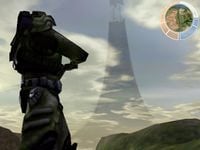
One of the early distinctions made about Halo in development was for there to be a clear distinction between The UNSC and Covenant design aesthetic, with the UNSC employing traditional ammuninition-based weaponry to differentiate from the aliens' high-tech plasma weapons. Artist Shi Kai Wang was employed to define the look of the Covenant, taking curvilinear forms from sea creatures, shells and iridescent textures from a horseshoe crab carapace, eventually defining the Covenant with a blue, purple and green colour scheme.[3] This direction took the form of the three "design schools" of Halo; the aforementioned human and Covenant, and the Forerunners with large cavernous and mysterious structures. This idea was spearheaded by Paul Russel.[61] The Covenant environments were primarily showcased in the level "The Truth and Reconciliation", with the original plan for the level involving a ramp the player would walk up to access the ship, intended to be low to the ground. However, the art team didn't want to have the player be able to inspect the ship up-close due to the low resolution of the in-game asset, so the gravity lift technology was conceived to to help provide the player with a way of entering the ship while keeping the vessel airborne. This idea proved to be more visually interesting that the level was structured around the gravity. [62]
To develop the characteristic feel of the Forerunners, Marcus Lehto treated the setting of Installation 04 as a character or entity unto itself - the team started with an idea of the ring's scale and function, and from there began to develop the Forerunner visual language. The ring's external surface and internal landmasses were created by concept painter Craig Mullins, who created a series of images showing the ring in various stages of disassembly with one pristine and new, one damaged and one on fire and coming apart. The ring's surface texture was gleaned from these paintings and later applied to the in-game 3D model.[63] Lehto felt that the structures on the surface of the ring were simply the tip of the iceberg, with each structure unique and filled with increasingly complex machinery beneath the surface. The Forerunner architecture was created through a process of trial and error, with the original style concepted in the old Chicago office a mix of Aztec and Louis B. Sullivan. The style was broken through with roughly five months before the game reached "content complete" status due to concept art created by Eddie Smith, who would produce several pieces of art depicting Forerunner structures.[56] Smith had little mandate or direction when he first started doing sketches of the Forerunner environments, but wanted to give the environment art team a starting point to begin their work on the levels. There was a vague notion of how things could look but nothing concrete, so Smith began to sketch based on the story synopsis, trying to differentiate from the existing Human and Covenant environments in a style he referred to as "streamlined industrial".[57]
For Russel, the Forerunner visual language solidified during the production of the level "The Silent Cartographer", during building the segments in which Master Chief descends into the interior of the map room. During development, Russel found the architecture beginning to evolve the deeper he went, and he kept improving and refining the formula as he continued on the level until he reached the bottom.[57] The swamps of Installation 04 found in the later level "343 Guilty Spark" were designed with lots of fog in the level for both mood and atmosphere reasons, but also to hide level geometry and save performance.[64] During the production of the level, artist Michael Wu spent a lot of time working on one of the signature mangrove trees in the level's start, characteristically referred to as the "evil tree".[65] Late in production, Griesemer worked on the level, placing the blood decals and Covenant barricades around.[44]
The human aesthetic - primarily that of the interiors of the UNSC Pillar of Autumn - was driven by Paul Russel's inspiration from the works of the artist Ron Cobb, who had done a number of instrumental work on developing the look of the Nostromo in Alien and the colony in Aliens. The interior of the vessel was designed to look believable and interesting, with drink vending machines, bulletin boards, and signs denoting various areas of the ship for the crew and the player. Paul tried to take the industrial look developed by Cobb for Alien and riff on that without turning into a blatant copy, wanting to show things in a functional way that looked like it fit together. The final result was a design direction which looked like it had been built by human hands.[66] Smith also provided concept artwork for the interior of the Autumn, with Lorraine McLees developing some of the exterior look. McLees' involvement in the game's production was primarily to do with visual branding and marketing and began working on the ship as everyone else on the team was too busy to do so. Griesemer and Lehto specified they wanted the vessel to look distinctly human, but the only human designs in the game at that point in time were the Warthog, weapons and a now-cut boat. McLees did a handful of sketches, and the team was drawn to one reminiscent of the shape of the assault rifle. At the request of Lehto, the ship was lengthened about three hundred percent to make it longer than tall.[67]
Weapons
 This section needs expansion. You can help Halopedia by expanding it.
This section needs expansion. You can help Halopedia by expanding it.
The first weapon developed for Halo was the assault rifle, originally a low-detail model built during the RTS days of the game's development. However, the team at Bungie liked the weapon's silhouette, so artist Robt McLees took to filling in the detail and evolving it into the MA5B assault rifle found in the final game. McLees was the only person at Bungie familiar with firearms during development, and had to constantly battle to make the human weapons feel like they could mechanically function in the real world as opposed to merely look cool, such as making sure the assault rifle had enough room for bolt travel. McLees' design process for the weapons involved drafting thumbnail sketches on paper with names, caliber, features and slang nicknames for the marine allies to use in-game. McLees continually reworked the rifle's ergonomics and design throughout development, but didn't discover until four months after ship that Belgian firearm manufacturer FN Herstal had produced a weapon with a very similar look around the same time - the FN 2000.[68]
A number of more exotic human grenade designs were concepted but the more conventional "pineapple" eventually won out.[69] Late in development, Jaime Greisemer was told he could only keep either the shotgun or the sniper rifle, but he and several other developers stayed up several nights to make sure both made the final cut.[3] However, a flamethrower was intended for the base game on Xbox but ultimately cut.[Note 4]
By the late stages of development, the now-infamous M6D magnum was still not where it was intended to be in the balance in either campaign or multiplayer. Due to the impracticalities of changing the raw data for the pistol's stats, Jason Jones wrote a script to update the pistol's damage value to a three-shot kill whenever a map or level loads.[70]
The Covenant Type-25 plasma pistol had been designed in some form by at least 1998.[71]
Vehicles
 This section needs expansion. You can help Halopedia by expanding it.
This section needs expansion. You can help Halopedia by expanding it.
The first vehicle developed for Halo was the M12 Warthog. During the RTS days of the game's development, the Warthog originated as the "Hummer" - a vehicle more resembling modern-day conventional Humvees employed by the US Military.[6] Over time, this evolved through a number of iterations before resembling the one found in the final game. The Warthog was made drivable with a third-person camera during the RTS builds to test the vehicle's physics in traversing the terrain, with the employees eventually finding merely driving the vehicle around to be fun, eventually prompting the change for Halo to become a third-person game. By 1998, a version of the Warthog modelled by Marcus Lehto was drivable on terrain and was noticeably more squat than the later vehicles with a flat bed and no turret.[49][Note 5] Another version was more armoured, and boasted a turret.[72] The 1999 Warthog shown at the Bungie 2002 Fanfest bears more resemblance to the final vehicle, though the version shown in the E3 2000 footage remains almost identical to the final game. However, this Warthog featured a rocket turret a opposed to the characteristic chaingun of the final release. This rocket turret visually resembles the Gauss cannon featured in Halo 2, though behaves more similarly to the rocket turret featured in the later release of Halo PC.
A variety of other military vehicles were designed for the human arsenal in the RTS stage of development. A number of armoured tank designs made it, albeit untextured, into the engine by 1998.[72] A larger selection never made it into mid or late-stage development, though two tank vehicles did. The "Stealth Tank" was a low-profiled, black-armoured main battle tank with "counter vented fire stabilisation"[73] featured in the third person builds of the game,[6] while the M808B Scorpion continued active development and made it into the final release. A number of other heavy armoured vehicle designs were concepted by Shi Kai Wang featuring a vastly different look, with turrets more resemblant of the "HK tank" from the Terminator franchise. Helicopters were another vehicle intended for inclusion in Halo, though ultimately cut because they weren't "futuristic enough".[6]
Watercraft were another vehicle type planned for inclusion in Halo. One watercraft was present in the early builds of the game, referred to as the "Doozy".[3][Note 6] Another boat was later shown off, described as looking like "two floating carrots".[6] It is possible the "Doozy" and this boat are one and the same.
Audio
 This section needs expansion. You can help Halopedia by expanding it.
This section needs expansion. You can help Halopedia by expanding it.
During the flashback cutscene of 343 Guilty Spark, Joseph Staten wanted Marty O'Donnell to license some rock music to play in the Pelican. Paint It Black by the Rolling Stones was considered for the choice, but O'Donnell and Salvatori created an original song; Shreddin', for use instead.[44]
Gallery
An early cover art draft from roughly 5–6 months prior to the launch of Halo: Combat Evolved.[74]
Another early thumbnail cover art that surfaced on a Canadian retailer's website.[75]
A file labelled "Halo Mission Icons 2" that was last edited during the development of Halo: Combat Evolved.[76]
Notes
- ^ Solipsis was the original name for the planet the ring orbited, now known in canon as Threshold.
- ^ This concept would later be considered for inclusion in Halo 2 as the Ark, before later being relegated to Halo 3 as the Voi portal.
- ^ This origin is remarkably similar to the origins of the Flood and its effects on Pheru later described in Halo: Cryptum and its sequels.
- ^ The flamethrower later made the cut for the 2003 release of the PC port, however.
- ^ This model bears a notable resemblance to the vehicle later included in Halo: Reach, the civilian Spade.
- ^ The Doozy, in canon is a snowmobile in use by the UNSC. A boat was concepted for inclusion in Halo 2 under the same name.
Sources
- ^ halo.bungie.org - RE: Armor
- ^ Armor trademark
- ^ a b c d e f g h i j k l m n o p q r s t u v w x y z aa ab ac ad VICE - The Complete, Untold History of Halo
- ^ a b c Bungie.net: Inside Bungie: History (Archived copy here)
- ^ Blam.net and Blam.org trademarks
- ^ a b c d e f g h i j k l Bungie.net: The Origin of Halo
- ^ a b c d e Youtube: GI Show: The Halo Spectacular (Feat. 343i, Jaime Griesemer, Marty O'Donnell) - (Interview begins at 56:04)
- ^ IGN: Heavenly "Halo"
- ^ PC Gamer: Your first look at... "Halo"
- ^ Twitter, Paul Russel (@docabominable): "No idea. It was on the initial list of names. Along with others like Solipsis (which is a current game title), Red Queen and maybe 20 more that I forgot." (Retrieved on Jul 10, 2022) [archive]
- ^ a b c d The Art of Halo: Creating a Virtual World - p. 73
- ^ a b c d e f g h i YouTube - Halo Archiver, Halo 3 Essential Disc 2: "7 Steps To World Domination/Cortana Chronicles".VOB
- ^ Twitter, Paul Russel (@docabominable): "I had a printout (the whiteboard was faked for the video), each title had a short definition. The sheet, (@Jimmy_McQ might’ve lost it) was from meeting 2, Halo was “a 3 dimensional orbit near one of three Lagrange points…”. My “ring in space the Covenant worship” didn’t inspire." (Retrieved on Jul 10, 2022) [archive]
- ^ Twitter, Paul Russel (@docabominable): "I’ve done lots of logo design and the quick spitballin’ phase is the most fun because you get to put to paper all the ridiculous stuff. You can see which parts of some of those designs Lorraine pulled together for the final logo. My thought was runes, unrecognizable as English." (Retrieved on Jul 10, 2022) [archive]
- ^ a b Twitter, Paul Russel (@docabominable): "Random sketchbook dump 1999: After Halo was picked as a title and the logo design"
- ^ Twitter, Paul Russel (@docabominable): "I only got a glance at them, there were maybe 30 ideas and I thumbed through them really fast. Seeing them is how I found out they chose Halo as the name, so I was also kind of stunned about that, too. I thought they hated it." (Retrieved on Jul 10, 2022) [archive]
- ^ a b c d Bungie.net, Halo 2: One Year Later (Retrieved on Jan 20, 2013) [archive]
- ^ halo.bungie.org - E3 Shenanigans
- ^ marathon.bungie.org - Blam!
- ^ Halo trademark
- ^ marathon.bungie.org: Transcript of Miguel Chavez's "The Jason Jones Macworld Expo NY Interview movie".
- ^ a b YouTube: O Brave New World
- ^ a b Youtube: Remaking the Legend - Halo 2: Anniversary - 3:10
- ^ a b halo.bungie.org: The Nathan Bitner Interview
- ^ Youtube: Halo - Macworld Unveiling
- ^ a b Rampancy.net: Halo Brings Action Gamers A World Without End
- ^ a b c halo.bungie.org: Interview: Bungie's Alexander Seropian
- ^ The Mac Observer: Bungie Software Brings In Distribution Partner, May Head Into Console Market
- ^ halo.bungie.org: "X-Box is a prime example of a console entering the market at the leading edge of technology, which is where we want our games to be"
- ^ a b Rampancy.net: Translation of the GameStar May 2000 Halo Preview
- ^ IGN: Halo - Bungie's ambitious first-person shooter is coming...
- ^ halo.bungie.org: Joseph Staten to head fourth development team at Bungie
- ^ halo.bungie.org: Marty O'Donnell discusses Halo's sound
- ^ Youtube: Halo: Combat Evolved E3 2000 trailer
- ^ halo.bungie.org: Press kit says Halo 60% done
- ^ a b c Bungie.net: Jason Jones Interviewed By You
- ^ halo.bungie.org: Halo 1st person view mode undecided as yet
- ^ a b IGN: The History of Halo
- ^ Paul Russel on Twitter: It's always going to be CE. We made 90% of the game in 9 months. I worked, that entire time, from January until early October 2001, 16-20 hours a day 6 days a week and from home on Sunday. It wrecked me for months after ship. Halo 2 had more studio strife, though.
- ^ halo.bungie.org: Re: That reminds me...
- ^ halo.bungie.org: Halo WILL ship for the Mac
- ^ halo.bungie.org: Microsoft says Mac and PC... of course!
- ^ a b Rampancy.net: 1/12/2000 Bungie update
- ^ a b c d e f g h i Halo 3 Legendary Edition - Halo: Combat Evolved developer commentary
- ^ The Art of Halo: Creating a Virtual World - p. 52
- ^ a b c Bungie.net: Feast of Bones
- ^ halo.bungie.org: Computer Gaming World 1999 scan
- ^ Marcus Lehto on Twitter: These are the oldest drawings of the Ark. Started playing around with this idea during Halo CE development
- ^ a b Marcus Lehto on Twitter: This is the very first Warthog I designed for Halo back in 1998. Old pc build only runs in wireframe now. Master Chief could go prone, crouch and drive this somewhat unwieldy vehicle around the map. Even had an early Forerunner Ark in the background! #warthog #halo #cybertruck
- ^ halo.bungie.org: Cortana's face was modeled after an Egyptian queen
- ^ The Art of Halo: Creating a Virtual World - p. 12
- ^ Twitter: Eric Trautmann Twitter thread on the origins of John-117 and Halsey
- ^ 343 Sparkast #6 (Archived copy available here
- ^ The Art of Halo: Creating a Virtual World - p. 5
- ^ Eurogamer: Better Than Halo: The Making of Halo 2 - Page 4
- ^ a b The Art of Halo: Creating a Virtual World - p. 79
- ^ a b c The Art of Halo: Creating a Virtual World - p. 80
- ^ YouTube: Question Session - Level Design - Hardy LeBel discusses the cut jetpacks.
- ^ Hardy LeBel discusses "Ruined Pain" - Screenshot of the comments section from "Question Session - Level Design" in which LeBel discusses cut levels
- ^ Marcus Lehto on Twitter: Sketch before building the first #Halo ring. Was my math way off for a 1.5hr rotation to provide Earth-like gravity?
- ^ The Art of Halo: Creating a Virtual World - p. 71
- ^ The Art of Halo: Creating a Virtual World - p. 85
- ^ The Art of Halo: Creating a Virtual World - p. 77
- ^ Gamasutra: 343 Industries' O'Connor Speaks Out On Halo: Anniversary's New Visuals
- ^ The Art of Halo: Creating a Virtual World - p. 82
- ^ The Art of Halo: Creating a Virtual World - p. 75
- ^ The Art of Halo: Creating a Virtual World - p. 125
- ^ The Art of Halo: Creating a Virtual World - p. 96-99
- ^ The Art of Halo: Creating a Virtual World - p. 107
- ^ IGN: Bungie Co-Founder, Halo and Destiny Creator Jason Jones Breaks 11-Year Silence
- ^ Marcus Lehto on Twitter: Our plasma pistol dates back to 1998 at least, so pretty sure Halo wins.
- ^ a b Marcus Lehto on Twitter: This vid of some very early Halo vehicles shows a slight upgrade to the Warthog, several human tanks, and a couple Forerunner and Covenant vehicles. #halo #warthog
- ^ Marcus Lehto on Twitter: Here's an old #Halo vehicle I built, the Stealth Tank. Low profile with counter vented fire stabilization.
- ^ Albert Penello on Twitter: I want to say about 6-7 months before launch. These would have been early drafts.
- ^ halo.bungie.org: Bizarre Thumbnail at Futureshop.ca
- ^ Twitter, Christopher Barrett (@cgbarrett): "“Last modified 21 years ago” - a file labeled Halo Mission Icons 2 - not sure if these ever were used?" (Retrieved on Mar 25, 2021) [archive]
![Sketches for the game's logo by Paul Russel.[15]](https://halo.wiki.gallery/images/thumb/3/32/HCE_Logos_Concept.jpg/68px-HCE_Logos_Concept.jpg)
![An early logo produced by a marketing agency.[17]](https://halo.wiki.gallery/images/thumb/4/48/HCE_EarlyBadLogo_1.jpg/200px-HCE_EarlyBadLogo_1.jpg)
![An early logo produced by a marketing agency.[17]](https://halo.wiki.gallery/images/thumb/9/99/HCE_EarlyBadLogo_2.jpg/174px-HCE_EarlyBadLogo_2.jpg)
![An early logo produced by Paul Russel.[17]](https://halo.wiki.gallery/images/thumb/1/16/HCE_EarlyBadLogo_3.jpg/200px-HCE_EarlyBadLogo_3.jpg)
![A near-final logo produced by Lorraine McLees.[17]](https://halo.wiki.gallery/images/thumb/3/3e/HCE_EarlyBadLogo_4.jpg/200px-HCE_EarlyBadLogo_4.jpg)
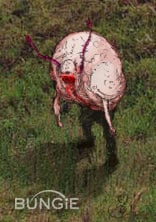
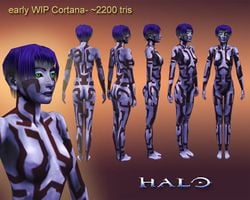
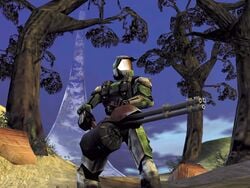
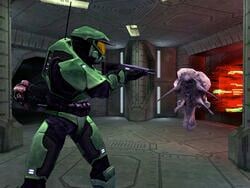
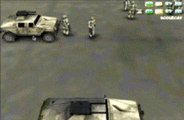
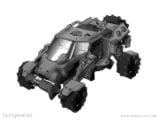
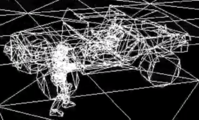
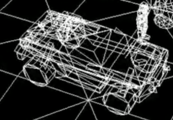
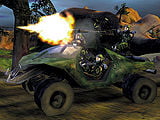
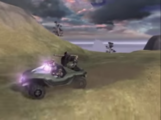
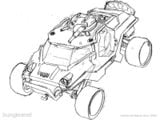
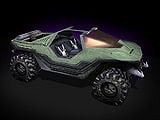
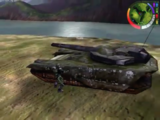
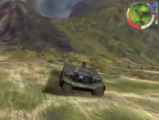
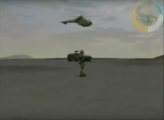
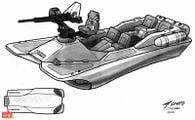
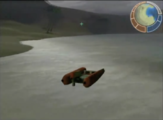
![An early cover art draft from roughly 5–6 months prior to the launch of Halo: Combat Evolved.[74]](https://halo.wiki.gallery/images/thumb/7/74/HCE_EarlyCoverArt_1.png/83px-HCE_EarlyCoverArt_1.png)
![Another early thumbnail cover art that surfaced on a Canadian retailer's website.[75]](https://halo.wiki.gallery/images/thumb/d/dd/HCE_EarlyCoverArt_2.gif/120px-HCE_EarlyCoverArt_2.gif)